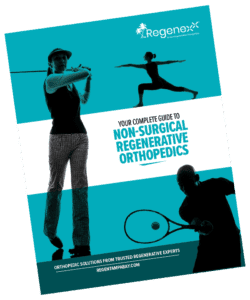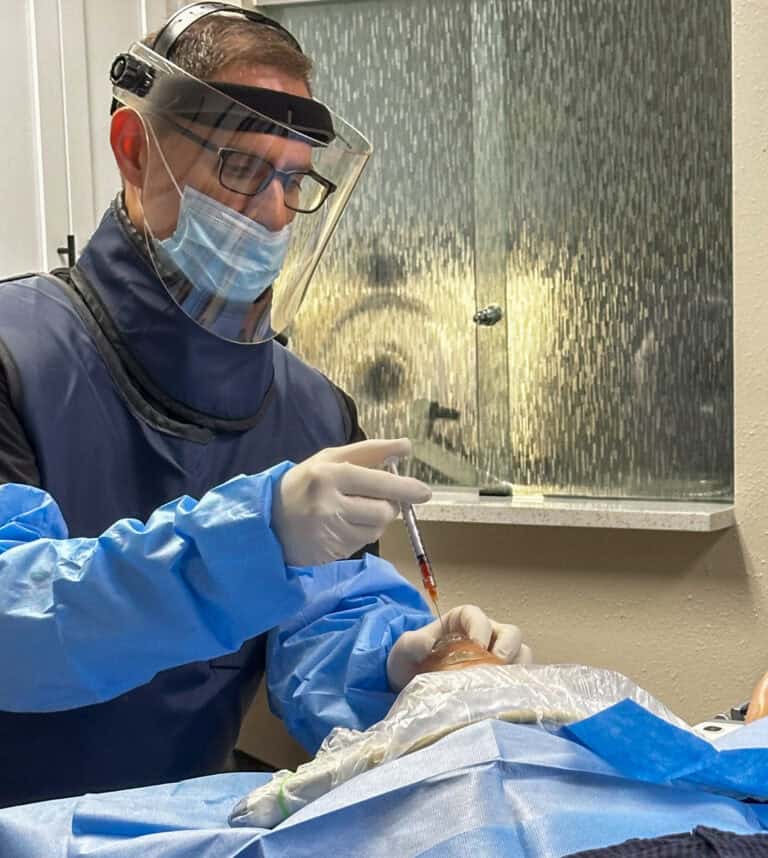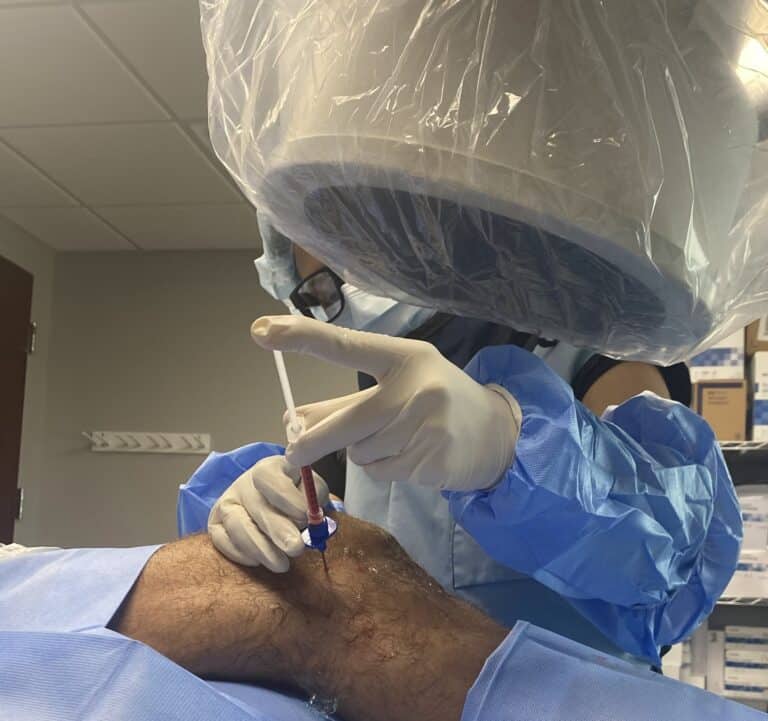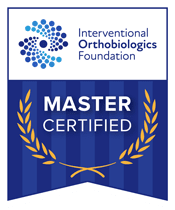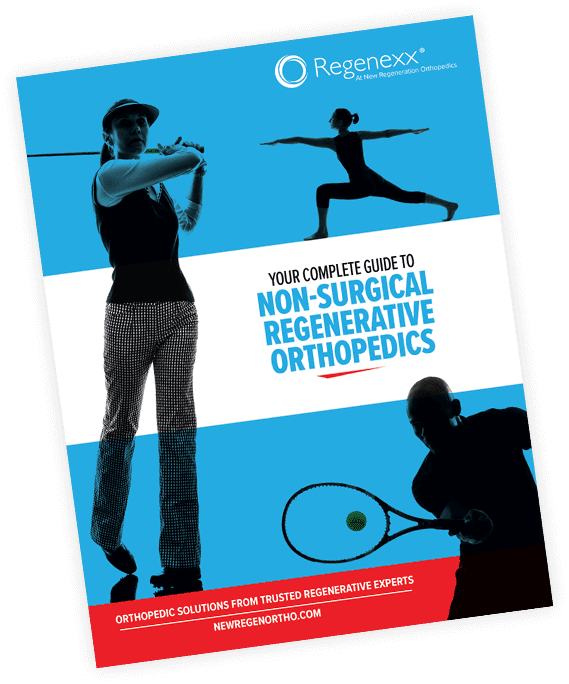The Evolution of Knee Replacements
In the 1970s, modern orthopedic surgery experienced a boom with the goal of correcting musculoskeletal issues. While at times surgery is a totally viable option, the trend became that surgery was a lot more frequent than it needed to be because there were no other options. The original models of orthopedic surgery in the 21st century went something like:
Musculoskeletal Pain → try pain killers and muscle relaxers → (if no improvement) Surgery
Then, in more recent decades the trend became a little more dependent on more barriers to surgery like:
Musculoskeletal Pain → X-Ray to rule out bony pathology → rest and/or conservative care like physical therapy for 6 weeks → if pain persists, MRI Imaging → If any tissue pathology is present, surgery is recommended.
However, the most modern option that we have been able to be a part of at Regenexx at New Regeneration Orthopedics has another layer of sophistication, adding in a step before surgery would be considered, like:
Musculoskeletal Pain → X-Ray to rule out bony pathology → rest and or conservative care like physical therapy for 6 weeks → If pain persists, MRI Imaging → recommend appropriate orthobiologic procedure (like PRP or Bone Marrow Concentrate) with post-procedural physical therapy → If marked pain still persists despite appropriate conservative treatment and therapy, surgery is recommended.
So before we talk about how PRP or bone marrow concentrate procedures are an awesome option for painful and arthritic knees, let’s go back to the development of orthopedic surgery for knees, specifically.
In the 1970s, knee joint replacements became prevalent; however, they were prevalent for a specific patient population. Total Knee Replacements (TKR) were only performed in an elderly population with pain severe enough it was limiting them from even their modest goals. We are talking to the tune of a pain-free grocery store outing.
This type of candidate is actually fitting for a TKR surgery, but the problem became that the knee replacements were being performed in younger and younger patients.
The Dawn of Knee Replacements in the Young
The younger and younger patients getting TKRs were in their 40s and 50s, and the reason is these folks were the product of the 1980s fitness craze. Chris Centeno, MD describes this phenomenon:
Richard Simmons, Jane Fonda, and Arnold in the movie “Pumping Iron” changed the boomer generation. Suddenly being fit was better than just being skinny. This was the first generation that wanted to be fit into their old age.
This generation is now careening towards or now meets the definition of “elderly.” Our medical practice [Regnexx] specializes in these patients who want to get much more out of their bodies than their parents.
So, we are seeing the boomer generation who got TKRs at 40 and 50 years old. And now, what’s even more interesting, is we are faced with observing the young, elite, specialized athletes from Gen X that got surgeries as teenagers. The orthopedic surgery landscape is now morphing into a longitudinal study where we can gauge the long-term effects of early surgery.

Young Knee Replacement Research
Thankfully, many researchers have already spearheaded a look at both the prevalence of TKR at varying ages as well as the long-term life of the replaced joint.
Lesiken et. al. explored the prevalence of TKR, and found that the frequency of TKR in a population aged 39-50 has increased 130-fold in the last few decades. The problem with these knee replacements in young individuals is:
- The knee replacement prostheses are only designed to last 10-20 years, suggesting these patients could require a second TKR in their lifetime.
- These young, active folks chasing the longevity of their high-performance have high expectations of the joint’s performance.
- Second knee replacement surgeries are much more complicated and riskier than the initial TKR surgery.
Anatone et.al. took a look at the lifetime of the replaced joint in varying ages in their study, Decreased Implant Survival is Associated With Younger Patients Undergoing Total Knee Arthroplasty published in the Musculoskeletal Journal of Hospital for Special Surgery. They analyzed insurance data on 114,698 patients between 2007-2015 and came up with this summary statement:
Revision-free implant survival at 5 years was significantly worse in patients younger than 60 years of age, particularly those less than 40 years, who had a 77% revision-free implant-survival rate at 5 years.
What’s the takeaway here? This means that if a patient was under 40 years of age when receiving a TKR, they were 23% more likely to need a second knee replacement within five years after the original procedure!
The Alternatives?
The impact from these studies is that young patients choosing TKR in their 40s and 50s are signing up to be riddled with follow-up surgeries. However, the true candidates for these are back to the 1970s edition: patients in their 60s-70s with conservative goals for their knee prostheses after the surgery.
Younger people experiencing knee pain or arthritis have medical technology on their side, since orthobiologics like PRP or Bone Marrow Concentrate injections are an excellent choice. These procedures for knee arthritis have an ever-growing body of research, showing quite the opposite of the studies referenced above. Instead of signing up for a second surgery in five years, the studies track the impact of orthobiologic procedures over 15 years and their longevity. These procedures are excellent options for young, active people with knee arthritis looking to beat pain but also push the possibility for a necessary TKR down the road.

